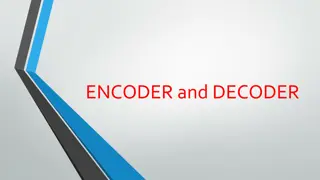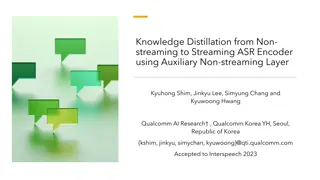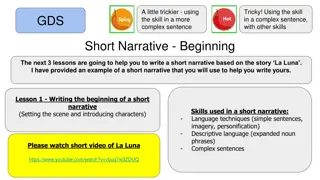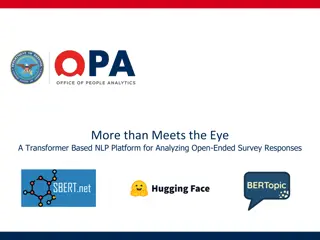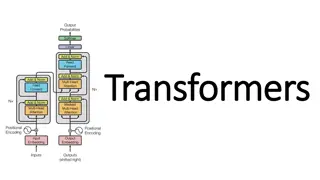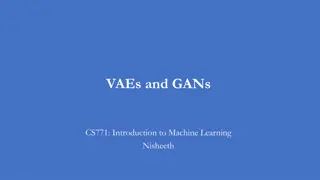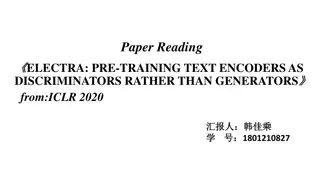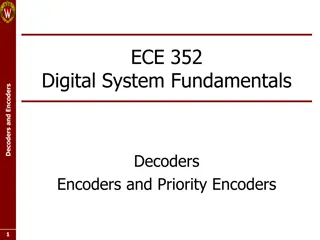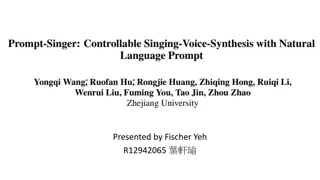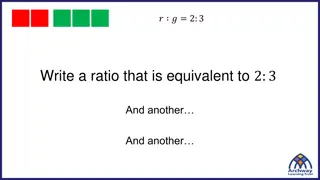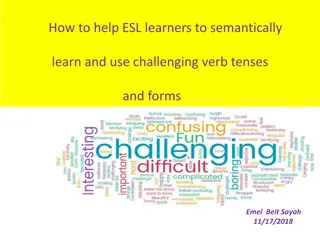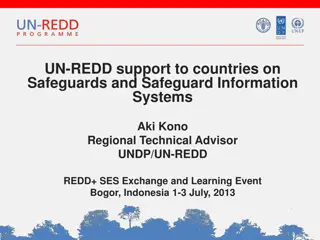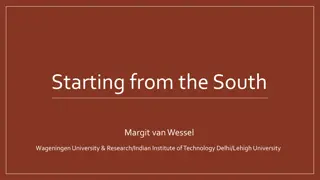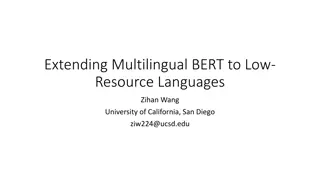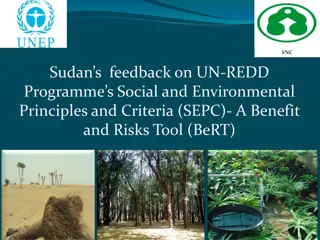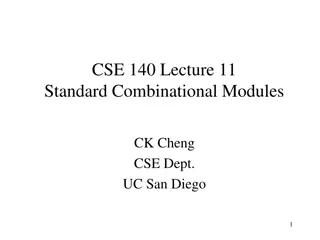A Comprehensive Overview of BERT and Contextualized Encoders
This informative content delves into the evolution and significance of BERT - a prominent model in NLP. It discusses the background history of text representations, introduces BERT and its pretraining tasks, and explores the various aspects and applications of contextualized language models. Delve into the origins, features, and practical implementations of BERT and related models within the realm of natural language processing.
Download Presentation

Please find below an Image/Link to download the presentation.
The content on the website is provided AS IS for your information and personal use only. It may not be sold, licensed, or shared on other websites without obtaining consent from the author.If you encounter any issues during the download, it is possible that the publisher has removed the file from their server.
You are allowed to download the files provided on this website for personal or commercial use, subject to the condition that they are used lawfully. All files are the property of their respective owners.
The content on the website is provided AS IS for your information and personal use only. It may not be sold, licensed, or shared on other websites without obtaining consent from the author.
E N D
Presentation Transcript
Which *BERT? A Survey Organizing Contextualized Encoders Patrick Xia Shijie Wu Benjamin Van Durme
Background History of Text Representations | Who is BERT? | About BERT and friends
A History of Text Representations Co-occurrence statistics Brown Clusters Count vectors, TF-IDF vectors, co-occurrence matrix decomposition Predictive word2vec, GloVe, CBOW, Skip-Gram, etc Contextualized language models Representation of word changes based on context CoVE, ELMo, GPT, BERT, etc
A History of Text Representations Co-occurrence statistics Brown Clusters Count vectors, TF-IDF vectors, co-occurrence matrix decomposition Predictive word2vec, GloVe, CBOW, Skip-Gram, etc Contextualized language models Representation of word changes based on context CoVE, ELMo, GPT, BERT, etc
A History of Text Representations Co-occurrence statistics Brown Clusters Count vectors, TF-IDF vectors, co-occurrence matrix decomposition Predictive word2vec, GloVe, CBOW, Skip-Gram, etc Contextualized language models Representation of word changes based on context CoVE, ELMo, GPT, BERT, etc
Who is BERT? BERT is a 12 (or 24) layer Transformer language model trained on two pretraining tasks, masked language modeling (fill-in-the-blank) and next sentence prediction (binary classification), and on English Wikipedia and BooksCorpus.
About BERT and friends How much language ? linguistic probing tasks, attention, few-shot evaluation Why this size and architecture? -base, -large, -small, -xl, etc. BERT is a 12 (or 24) layer Transformer language model trained on two pretraining tasks, masked language modeling (fill-in-the-blank) Why these tasks? XLNet, ELECTRA, SpanBERT, LXMERT, etc. and next sentence prediction (binary classification), and on English Other languages? Wikipedia and BooksCorpus. mBERT, XLM, XLM-R, mT5, RuBERT, etc What s special about this data? BioBERT, Covid-Twitter-BERT, etc
Using these *BERTs Pretrain finetune Pretrain encoders on pretraining tasks (high-resource/data, possibly unsupervised) Finetune encoders on target task (low-resource, expensive annotation) Primary method of evaluation: Natural Language Understanding (NLU) Question Answering and Reading Comprehension Commonsense Textual Entailments
Using these *BERTs Pretrain finetune Pretrain encoders on pretraining tasks (high-resource/data, possibly unsupervised) Finetune encoders on target task (low-resource, expensive annotation) Primary method of evaluation: Natural Language Understanding (NLU) Question Answering and Reading Comprehension Commonsense Textual Entailments
Using these *BERTs Pretrain finetune Pretrain encoders on pretraining tasks (high-resource/data, possibly unsupervised) Finetune encoders on target task (low-resource, expensive annotation) Primary method of evaluation: Natural Language Understanding (NLU) Question Answering and Reading Comprehension Commonsense Textual Entailments
Using these *BERTs Pretrain finetune Pretrain encoders on pretraining tasks (high-resource/data, possibly unsupervised) Finetune encoders on target task (low-resource, expensive annotation) Primary method of evaluation: Natural Language Understanding (NLU) Question Answering and Reading Comprehension Commonsense Textual Entailments
Using these *BERTs Pretrain finetune Pretrain encoders on pretraining tasks (high-resource/data, possibly unsupervised) Finetune encoders on target task (low-resource, expensive annotation) Primary method of evaluation: Natural Language Understanding (NLU) Question Answering and Reading Comprehension Commonsense Textual Entailments
Using these *BERTs Pretrain finetune Pretrain encoders on pretraining tasks (high-resource/data, possibly unsupervised) Finetune encoders on target task (low-resource, expensive annotation) Primary method of evaluation: Natural Language Understanding (NLU) Question Answering and Reading Comprehension Commonsense Textual Entailments
Using these *BERTs Pretrain finetune Pretrain encoders on pretraining tasks (high-resource/data, possibly unsupervised) Finetune encoders on target task (low-resource, expensive annotation) Primary method of evaluation: Natural Language Understanding (NLU) Question Answering and Reading Comprehension Commonsense Textual Entailments
The story so far Pretraining | Efficiency | Data | Interpretability | Multilinguality
Pretraining Quantitative improvements in downstream tasks are made through pretraining methods Predict tokens in text Masked language modeling Masked token/word/span prediction Replaced word prediction Predict other signals Next sentence/segment prediction Discourse relations Grounding To KB Visual/multimodal
Pretraining Masked language modeling What is natural language processing ? What is natural language [mask]? What is [mask] processing? Who is natural language processing? Replaced word prediction Masked span prediction Masked token prediction
Pretraining Predict other signals Next sentence prediction Discourse markers/relations Real-world knowledge: knowledge base/IR scores Visual and multimodal grounding
Efficiency Training: Faster convergence with improved optimizers, hardware Inference size/time: Large small: knowledge distillation, pruning Start small: parameter sharing/factorization, quantization Are these techniques compared equally? Do we care about %parameter reduction? Memory? Inference time? These don t necessarily correlate Do we care about all tasks or just downstream one(s)?
Efficiency Training: Faster convergence with improved optimizers, hardware Inference size/time: Large small: knowledge distillation, pruning Start small: parameter sharing/factorization, quantization Are these techniques compared equally? Do we care about %parameter reduction? Memory? Inference time? These don t necessarily correlate Do we care about all tasks or just downstream one(s)?
Efficiency Training: Faster convergence with improved optimizers, hardware Inference size/time: Large small: knowledge distillation, pruning Start small: parameter sharing/factorization, quantization Are these techniques compared equally? Do we care about %parameter reduction? Memory? Inference time? These don t necessarily correlate Do we care about all tasks or just downstream one(s)?
Efficiency Training: Faster convergence with improved optimizers, hardware Inference size/time: Large small: knowledge distillation, pruning Start small: parameter sharing/factorization, quantization Are these techniques compared equally? Do we care about %parameter reduction? Memory? Inference time? These don t necessarily correlate Do we care about all tasks or just downstream one(s)?
Efficiency Training: Faster convergence with improved optimizers, hardware Inference size/time: Large small: knowledge distillation, pruning Start small: parameter sharing/factorization, quantization Are these techniques compared equally? Do we care about %parameter reduction? Memory? Inference time? These don t necessarily correlate Do we care about all tasks or just downstream one(s)?
Data Quantity: more data is better Are comparisons across encoders fair? Quality: clean, in-domain, data is better What are our test sets? Where is our data coming from?? Do we know what biases the contextualized encoders learn? Should we use biased model in real systems?
Data Quantity: more data is better Are comparisons across encoders fair? Quality: clean, in-domain, data is better What are our test sets? Where is our data coming from?? Do we know what biases the contextualized encoders learn? Should we use biased model in real systems?
Data Quantity: more data is better Are comparisons across encoders fair? Quality: clean, in-domain, data is better What are our test sets? Where is our data coming from?? Do we know what biases the contextualized encoders learn? Should we use biased model in real systems?
Data Quantity: more data is better Are comparisons across encoders fair? Quality: clean, in-domain, data is better What are our test sets? Where is our data coming from?? Do we know what biases the contextualized encoders learn? Should we use biased model in real systems?
Data Quantity: more data is better Are comparisons across encoders fair? Quality: clean, in-domain, data is better What are our test sets? Where is our data coming from?? Do we know what biases the contextualized encoders learn? Should we use biased model in real systems?
Data Quantity: more data is better Are comparisons across encoders fair? Quality: clean, in-domain, data is better What are our test sets? Where is our data coming from?? Do we know what biases the contextualized encoders learn? Should we use biased model in real systems?
Data Quantity: more data is better Are comparisons across encoders fair? Quality: clean, in-domain, data is better What are our test sets? Where is our data coming from?? Do we know what biases the contextualized encoders learn? Should we use biased model in real systems?
Interpretability Task probing Finetune pretrained models to test specific linguistic phenomenon Model weight inspection Visualize weights for important words in input or layers in model Input Prompting Force language models to fill in or complete text None of these methods are perfect Task probing: more finetuning Weight inspection: not reliable Prompting: picking the prompt is critical
Interpretability Task probing Finetune pretrained models to test specific linguistic phenomenon Model weight inspection Visualize weights for important words in input or layers in model Input Prompting Force language models to fill in or complete text None of these methods are perfect Task probing: more finetuning Weight inspection: not reliable Prompting: picking the prompt is critical
Interpretability Task probing Finetune pretrained models to test specific linguistic phenomenon Model weight inspection Visualize weights for important words in input or layers in model Input Prompting Force language models to fill in or complete text None of these methods are perfect Task probing: more finetuning Weight inspection: not reliable Prompting: picking the prompt is critical
Interpretability Task probing Finetune pretrained models to test specific linguistic phenomenon Model weight inspection Visualize weights for important words in input or layers in model Input Prompting Force language models to fill in or complete text None of these methods are perfect Task probing: more finetuning Weight inspection: not reliable Prompting: picking the prompt is critical
Interpretability Task probing Finetune pretrained models to test specific linguistic phenomenon Model weight inspection Visualize weights for important words in input or layers in model Input Prompting Force language models to fill in or complete text None of these methods are perfect Task probing: more finetuning Weight inspection: not reliable Prompting: picking the prompt is critical
Interpretability Task probing Finetune pretrained models to test specific linguistic phenomenon Model weight inspection Visualize weights for important words in input or layers in model Input Prompting Force language models to fill in or complete text None of these methods are perfect Task probing: more finetuning Weight inspection: not reliable Prompting: picking the prompt is critical
Interpretability Task probing Finetune pretrained models to test specific linguistic phenomenon Model weight inspection Visualize weights for important words in input or layers in model Input Prompting Force language models to fill in or complete text None of these methods are perfect Task probing: more finetuning Weight inspection: not reliable Prompting: picking the prompt is critical
Multilinguality A single encoder on multilingual text with shared input vocabulary These models do well! Why? Shared vocabulary Shared (upper) layers Deep networks Embeddings across languages can be aligned When are multilingual models good?
Multilinguality A single encoder on multilingual text with shared input vocabulary These models do well! Why? Shared vocabulary Shared (upper) layers Deep networks Embeddings across languages can be aligned When are multilingual models good?
Multilinguality A single encoder on multilingual text with shared input vocabulary These models do well! Why? Shared vocabulary Shared (upper) layers Deep networks Embeddings across languages can be aligned When are multilingual models good?
Multilinguality A single encoder on multilingual text with shared input vocabulary These models do well! Why? Shared vocabulary Shared (upper) layers Deep networks Embeddings across languages can be aligned When are multilingual models good?
Multilinguality A single encoder on multilingual text with shared input vocabulary These models do well! Why? Shared vocabulary Shared (upper) layers Deep networks Embeddings across languages can be aligned When are multilingual models good?
Multilinguality A single encoder on multilingual text with shared input vocabulary These models do well! Why? Shared vocabulary Shared (upper) layers Deep networks Embeddings across languages can be aligned When are multilingual models good?
Multilinguality A single encoder on multilingual text with shared input vocabulary These models do well! Why? Shared vocabulary Shared (upper) layers Deep networks Embeddings across languages can be aligned When are multilingual models good?
Shortcomings Leaderboards | Overfitting our understanding | Expensive evaluations
Leaderboards without a leader There s good science in 2nd place: who is responsible for publishing when reviewers demand 1st? Publicize and publish negative results Leaderboard owners should be responsible for frequently surveying submissions A leaderboard is not just a dataset: it s an unending shared task Shared tasks need summaries discussing all the methods
Leaderboards without a leader There s good science in 2nd place: who is responsible for publishing when reviewers demand 1st? Publicize and publish negative results Leaderboard owners should be responsible for frequently surveying submissions A leaderboard is not just a dataset: it s an unending shared task Shared tasks need summaries discussing all the methods
Leaderboards without a leader There s good science in 2nd place: who is responsible for publishing when reviewers demand 1st? Publicize and publish negative results Leaderboard owners should be responsible for frequently surveying submissions A leaderboard is not just a dataset: it s an unending shared task Shared tasks need summaries discussing all the methods
Leaderboards without a leader There s good science in 2nd place: who is responsible for publishing when reviewers demand 1st? Publicize and publish negative results Leaderboard owners should be responsible for frequently surveying submissions A leaderboard is not just a dataset: it s an unending shared task Shared tasks need summaries discussing all the methods
Leaderboards without a leader There s good science in 2nd place: who is responsible for publishing when reviewers demand 1st? Publicize and publish negative results Leaderboard owners should be responsible for frequently surveying submissions A leaderboard is not just a dataset: it s an unending shared task Shared tasks need summaries discussing all the methods



